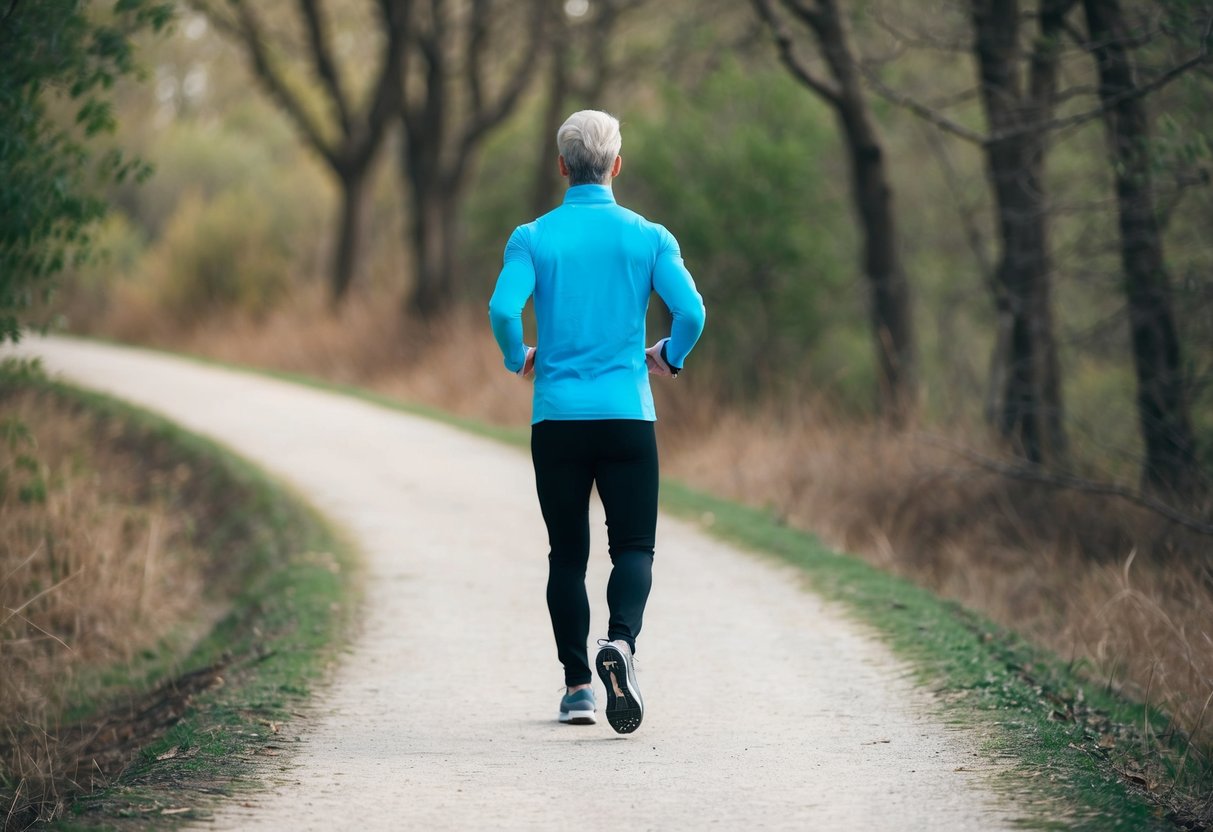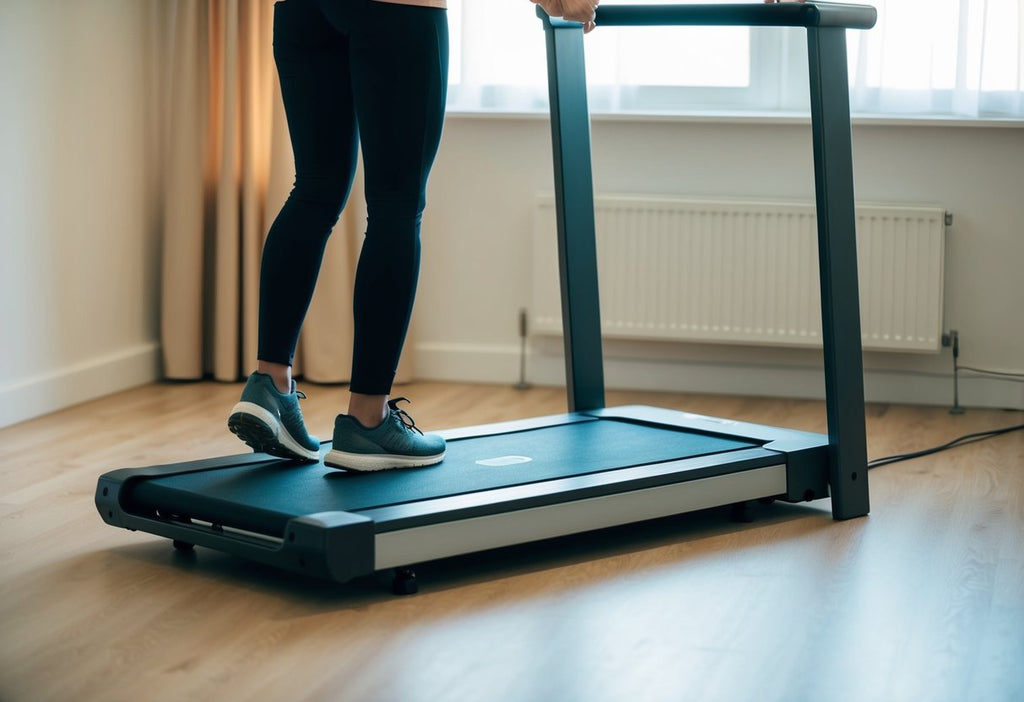The Role of Walking in Recovery from Injuries

Don’t forget to check out our Pacerocker, Trailviber, and Trailviber Auto Incline walking pad treadmills.
Walking plays a crucial role in recovery from injuries, offering a gentle yet effective way to regain strength and mobility. This low-impact exercise promotes healing by increasing blood flow, reducing stiffness, and rebuilding muscle without putting excessive stress on the body. We've seen countless patients benefit from incorporating walking into their rehabilitation programs.
For many injuries, walking serves as a bridge between initial rest and more intensive physical therapy. It helps maintain cardiovascular fitness while allowing injured areas to heal. We often recommend starting with short, manageable walks and gradually increasing duration and intensity as recovery progresses.
Walking also provides mental health benefits during the recovery process. It can boost mood, reduce stress, and give patients a sense of progress and control over their healing journey. We encourage those recovering from injuries to view walking not just as exercise, but as an integral part of their overall well-being.
Key Takeaways
- Walking promotes healing by increasing blood flow and reducing stiffness
- Gradual progression from short walks to longer durations aids safe recovery
- Regular walking improves both physical and mental well-being during rehabilitation
Understanding Injury Recovery
Injury recovery involves complex biological processes and strategic approaches to regain function. Proper healing and rehabilitation are crucial for returning to normal activities and preventing future issues.
Phases of Healing
The body's healing process follows distinct stages. In the inflammatory phase, blood flow increases to the injured area, bringing essential cells and nutrients. This phase typically lasts a few days.
Next comes the proliferative phase, where new tissue forms. Collagen production ramps up, creating a foundation for repair. This phase can last several weeks, depending on the injury's severity.
The final stage is remodeling. Here, the new tissue gains strength and flexibility. This phase can continue for months or even years after the initial injury.
Impact of Mobility on Recovery
Early, controlled movement plays a vital role in recovery. Gentle exercises improve blood flow, reducing swelling and stiffness. This enhanced circulation delivers more oxygen and nutrients to the healing tissues.
We've found that appropriate mobility can prevent muscle atrophy and joint stiffness. It also helps maintain range of motion, which is crucial for long-term function.
However, it's essential to balance rest and activity. Too much stress on healing tissues can delay recovery or cause further damage. We always recommend following a healthcare professional's guidance for safe and effective rehabilitation.
Benefits of Walking
Walking offers numerous advantages for those recovering from injuries. It's a gentle yet effective form of exercise that can aid healing and promote overall well-being.
Enhancing Circulation
Walking boosts blood flow throughout the body. This increased circulation delivers more oxygen and nutrients to injured tissues, speeding up the healing process. We've observed that even short walks can make a difference.
Regular walking strengthens the heart, improving its ability to pump blood efficiently. This enhanced cardiovascular function benefits not just the injured area, but the entire body.
For those with lower limb injuries, walking helps prevent blood clots by promoting movement in the legs. It's especially crucial for individuals who've been immobile for extended periods.
Reducing Inflammation
Walking plays a key role in managing inflammation, a common issue during injury recovery. The gentle movement stimulates the lymphatic system, helping to flush out toxins and reduce swelling.
As we walk, our bodies release anti-inflammatory compounds. These natural substances help alleviate pain and promote faster healing.
Consistent low-impact exercise like walking can also help break up adhesions and prevent excessive scar tissue formation. This is particularly beneficial for maintaining flexibility and range of motion in the affected area.
Promoting Mental Health
The psychological benefits of walking during recovery are significant. Regular walks can boost mood and reduce stress, anxiety, and depression often associated with injury-related downtime.
Walking outdoors exposes us to natural light, which helps regulate sleep patterns and improve overall well-being. It's a simple way to combat the feelings of isolation that sometimes accompany recovery periods.
We've found that walking provides a sense of progress and accomplishment. It allows individuals to set achievable goals, boosting confidence and motivation throughout the healing journey.
Planning Your Recovery Walks
Effective recovery walks require thoughtful planning and integration into your rehabilitation program. Let's explore how to set achievable goals and incorporate walking into your recovery journey.
Setting Realistic Goals
We recommend starting with short, manageable walks and gradually increasing duration and intensity. Begin with 5-10 minute walks, 2-3 times a day, depending on your injury and doctor's advice. As you progress, aim to add 1-2 minutes each day or every other day.
Track your progress using a journal or smartphone app. This helps us monitor improvements and stay motivated. Set weekly goals, such as increasing total daily walking time by 5 minutes or adding one extra walk per day.
Remember to listen to your body. If pain increases, scale back and consult your healthcare provider.
Incorporating Walking Into Rehabilitation
We suggest integrating walking with other rehab exercises for a well-rounded recovery plan. Schedule walks between strength training or physical therapy sessions to maintain a steady activity level throughout the day.
Use walking as a warm-up before more intense rehab exercises. This increases blood flow and prepares muscles for work. Alternatively, gentle walks can serve as a cool-down after therapy sessions.
Consider terrain variety to challenge different muscle groups. Start on flat surfaces, then progress to slight inclines or uneven ground as strength improves. Always prioritize safety and consult your physical therapist for guidance on appropriate terrain.
Walking Techniques and Injury Prevention
Proper walking techniques and appropriate footwear are crucial for injury prevention and recovery. Let's explore how to walk safely and choose the right shoes to support healing.
Proper Walking Form
We always start with good posture. Keep our head up, shoulders back, and core engaged. Our arms should swing naturally at our sides.
When taking a step, we land on our heel first. Then we roll through the foot, pushing off with our toes. This heel-to-toe motion helps distribute our weight evenly.
We aim for a comfortable stride length. Overstriding can strain our muscles and joints. Short, quick steps are often better for recovery.
Breathing is key too. We inhale deeply through our nose and exhale through our mouth. This helps oxygenate our muscles and reduce fatigue.
Choosing the Right Footwear
Supportive shoes are essential for safe walking during recovery. We look for shoes with good arch support and cushioning. This helps absorb shock and reduce stress on our joints.
The shoe's fit is crucial. We ensure there's enough room in the toe box to wiggle our toes. The heel should fit snugly without slipping.
For stability, we choose shoes with a wide, flat sole. This provides a solid base and helps prevent ankle rolls.
We replace our walking shoes regularly. Worn-out shoes can lead to poor alignment and increase injury risk. Generally, we swap them out every 300-500 miles of use.
Adapting Walking Routines for Different Injuries
Walking can be a valuable part of recovery for many injuries, but the approach needs to be tailored to the specific condition. The right adaptations can promote healing while preventing further harm.
Lower Body Injuries
For knee injuries, we recommend starting with short, flat walks on even surfaces. Gradually increase duration as pain allows. Supportive shoes are crucial to minimize stress on the joint.
Ankle sprains benefit from a progressive approach. Begin with gentle ankle rolls and foot flexes before attempting short walks. Use an ankle brace for added stability if advised by a healthcare professional.
Hip injuries often require a slower pace and shorter stride length. We suggest using walking poles to reduce weight-bearing and maintain balance. Avoid hills and uneven terrain initially.
For foot injuries like plantar fasciitis, proper footwear is key. Look for shoes with arch support and cushioning. Start with brief walks and slowly build up time and distance as symptoms improve.
Upper Body Injuries
Shoulder injuries don't typically prevent walking, but arm movement should be limited. We recommend using a sling if prescribed and focusing on maintaining good posture while walking.
For back injuries, start with short, frequent walks rather than long sessions. Maintain a neutral spine position and avoid twisting movements. Consider using a lumbar support belt if recommended by your doctor.
Neck injuries require careful attention to posture during walks. Keep your chin tucked slightly and look straight ahead. Avoid sudden head movements and consider using a soft collar if advised.
Wrist or hand injuries generally don't interfere with walking. However, if using crutches or a cane, ensure proper technique to avoid strain on the injured area.
Monitoring Progress and Adjusting Your Approach
Tracking improvements and listening to your body are essential aspects of walking for injury recovery. These practices help ensure safe and effective rehabilitation.
Tracking Improvements
We recommend keeping a recovery journal to document our walking progress. This simple tool allows us to record daily distances, duration, and any discomfort experienced. Over time, we'll notice gradual improvements in our endurance and reduced pain levels.
It's helpful to set small, achievable goals each week. We might aim to increase our walking time by 5 minutes or add an extra block to our route. Celebrating these milestones boosts motivation and reinforces our commitment to recovery.
Regular check-ins with our healthcare provider are crucial. They can assess our progress objectively and adjust our walking plan as needed. We should bring our recovery journal to these appointments, as it provides valuable insights into our day-to-day experiences.
Listening to Your Body
Paying attention to how we feel during and after walks is crucial for safe recovery. If we experience increased pain, swelling, or discomfort, it's a sign to slow down or reduce our walking intensity.
We shouldn't ignore persistent pain or new symptoms. These could indicate we're pushing too hard or that our injury needs further attention. It's always better to err on the side of caution and consult our healthcare provider if we have concerns.
Rest days are just as important as walking days. Our bodies need time to recover and adapt to increased activity. We should listen when our bodies signal the need for extra rest and not feel guilty about taking a day off from our walking routine.
Nutrition and Hydration for Optimal Recovery
Proper nutrition and hydration play crucial roles in supporting the body's healing processes during injury recovery. The right nutrients and adequate fluid intake can accelerate tissue repair and reduce inflammation.
Essential Nutrients
Protein is vital for rebuilding damaged tissues. We recommend consuming lean meats, fish, eggs, and plant-based sources like beans and lentils. Aim for 1.2-2.0 grams of protein per kilogram of body weight daily.
Vitamins C and E are powerful antioxidants that fight inflammation. Include citrus fruits, berries, and leafy greens in your diet. Nuts and seeds provide vitamin E along with healthy fats.
Omega-3 fatty acids reduce inflammation and support joint health. Incorporate fatty fish like salmon or sardines twice a week. Flaxseeds and walnuts are excellent plant-based options.
Calcium and vitamin D are essential for bone health. Dairy products, fortified plant milks, and leafy greens are great sources. Spend time outdoors for natural vitamin D synthesis.
Hydration Strategies
Staying well-hydrated is crucial for nutrient transport and waste removal. We suggest drinking water throughout the day, aiming for 8-10 glasses.
Electrolyte-rich beverages can be beneficial after intense physical therapy sessions. Coconut water or low-sugar sports drinks help replenish lost minerals.
Herbal teas like ginger or turmeric can provide additional anti-inflammatory benefits. Limit caffeine and alcohol intake as they can interfere with hydration and sleep quality.
Monitor urine color as an indicator of hydration status. Pale yellow indicates good hydration, while dark yellow suggests you need to drink more water.
Professional Guidance and Support
Seeking expert advice and connecting with others can significantly enhance the recovery process through walking. Professional guidance ensures safe and effective rehabilitation, while support groups provide motivation and shared experiences.
Working with Physical Therapists
Physical therapists play a crucial role in designing personalized walking programs for injury recovery. We've found that these experts assess each patient's condition and create tailored plans to gradually increase mobility. They teach proper walking techniques, recommend suitable footwear, and monitor progress closely.
Physical therapists also introduce helpful tools like crutches or walking aids when necessary. They guide patients through specific exercises to improve strength and flexibility, complementing the walking routine. Regular check-ins with therapists allow for adjustments to the recovery plan as needed.
Support Groups and Communities
Joining support groups can make a world of difference in the recovery journey. We've seen how these communities provide emotional support and practical advice from others who've faced similar challenges. Online forums and local meetups offer platforms to share experiences, tips, and motivation.
Many hospitals and rehabilitation centers organize walking groups for recovering patients. These groups create a sense of camaraderie and accountability. Participants often find it easier to stick to their walking routines when they have peers to walk with and cheer them on.
Some communities even organize events like charity walks, giving recovering individuals a goal to work towards. This social aspect of recovery can boost morale and speed up the healing process.
Long-Term Strategies for Maintaining Mobility
Walking plays a crucial role in recovery, but sustaining mobility requires ongoing effort. We'll explore key strategies to keep you moving well into the future.
Regular Exercise Regimen
We recommend incorporating a mix of activities to support long-term mobility. Aim for 150 minutes of moderate aerobic exercise weekly, including brisk walking, swimming, or cycling. Add strength training 2-3 times a week to build muscle and bone density.
Flexibility exercises are essential. Try yoga or stretching routines to maintain joint range of motion. Balance exercises like tai chi can reduce fall risk as we age.
Here's a sample weekly plan:
- Monday: 30-minute walk, 15-minute strength training
- Tuesday: 45-minute swim
- Wednesday: 30-minute yoga session
- Thursday: 30-minute walk, 15-minute balance exercises
- Friday: 45-minute bike ride
- Saturday: 30-minute strength training
- Sunday: Rest or gentle stretching
Lifestyle Adjustments
Small changes in daily habits can have a big impact on mobility. We suggest taking the stairs instead of elevators when possible. Park further from entrances to add extra steps to your day.
Consider a standing desk or active sitting chair to reduce prolonged sitting. Set reminders to move every hour if your job is sedentary.
Proper nutrition supports joint health and muscle function. Include anti-inflammatory foods like:
- Fatty fish (salmon, mackerel)
- Leafy greens
- Nuts and seeds
- Berries
Stay hydrated to keep joints lubricated. Aim for 8 glasses of water daily.
Quality sleep is crucial for recovery and mobility. Create a relaxing bedtime routine and aim for 7-9 hours nightly.
Frequently Asked Questions
Walking plays a crucial role in injury recovery. Let's explore some common questions about its benefits and best practices.
Can walking have a positive impact on the healing process?
Yes, walking can significantly aid the healing process. It promotes blood circulation, which delivers oxygen and nutrients to injured tissues. Walking also helps reduce inflammation and swelling in the affected area.
What specific benefits does walking provide during the rehabilitation phase?
Walking strengthens muscles and improves flexibility. It enhances balance and coordination, reducing the risk of future injuries. Walking also boosts mood and mental well-being, crucial aspects of recovery.
How much walking is recommended for someone recovering from an injury?
The ideal amount varies based on the injury and individual. We typically suggest starting with short 5-10 minute walks, 2-3 times daily. Gradually increase duration and frequency as pain and mobility improve.
Are there particular types of injuries where walking is especially beneficial?
Walking is particularly helpful for lower body injuries like ankle sprains and knee strains. It's also beneficial for back pain and post-surgery recovery. Even upper body injuries can benefit from the overall circulation boost walking provides.
What precautions should one take while walking to avoid aggravating an injury?
Wear supportive shoes and use assistive devices if needed. Start on flat, even surfaces. Listen to your body and stop if pain increases. Avoid overexertion and maintain proper posture throughout the walk.
Could walking too much delay injury recovery and how can one find a balance?
Excessive walking can indeed hinder recovery. Pay attention to pain levels and fatigue. We recommend consulting a healthcare professional to create a personalized walking plan. They can help adjust intensity and duration based on your progress.
Discover the healing benefits of walking for injury recovery: a gentle way to improve strength, mobility, and mental health without straining the body.







